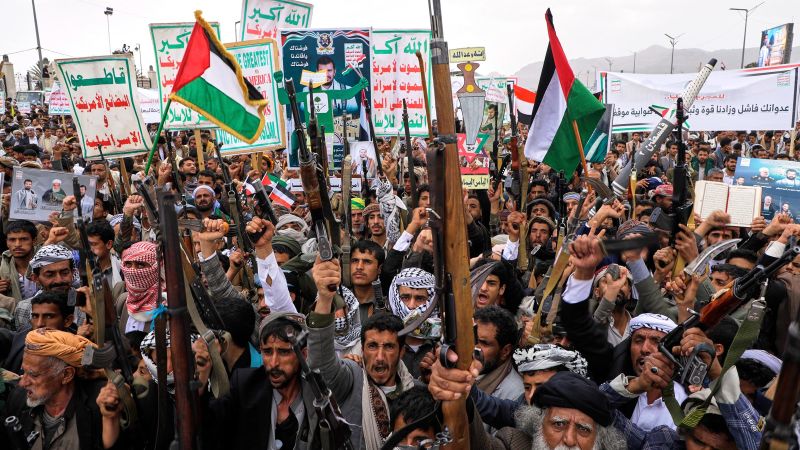In recent developments, the United States has launched a significant military campaign aimed at neutralizing the Houthi rebel group in Yemen. However, the operational success of this campaign has faced serious challenges due to the Houthis’ increasing effectiveness in downing American drones. Reports indicate that since the commencement of hostilities approximately a month ago, the Houthis have successfully shot down at least seven high-value American drones, disrupting the U.S. strategy and hindering its transition into what officials have termed “phase two” of the operation.
U.S. officials had initially aimed to establish air superiority over Yemen within a period of thirty days. This objective included degrading Houthi air defense capabilities sufficiently to facilitate a renewed focus on intelligence, reconnaissance, and surveillance. The ultimate goal was to locate and eliminate key Houthi leaders. The MQ-9 Reaper drones, which are integral to this mission, have been consistently targeted by the Houthis, who appear to be enhancing their capabilities in this regard. Given that there are no ground troops deployed in Yemen, the U.S. relies heavily on aerial surveillance conducted by these drones to assess battlefield conditions and monitor the activities of suspected terrorists.
Despite these challenges, U.S. forces have managed to conduct a large number of strikes against Houthi targets. Reports mention that over 700 targets have been hit, with more than 300 airstrikes undertaken since the campaign began on March 15. While these attacks have pressured the Houthis, forcing them to operate covertly, adverse conditions have consistently affected U.S. operational assessments. Prolonged drone losses have made it increasingly difficult to ascertain the extent to which U.S. operations have impaired the Houthi arsenal.
In a span of about six weeks, the Houthis reportedly launched numerous aerial attacks, including 77 one-way drones and various missile systems targeting U.S. forces, commercial vessels, and even Israel. In light of these developments, intelligence assessments suggest that despite the U.S. bombardment, the Houthis remain capable of launching missile strikes at U.S. assets and maintaining their command-and-control structure unscathed, which relies heavily on signals intelligence.
When asked about the impact of downed drones, U.S. defense officials acknowledged the issue but emphasized the ongoing investigation into each incident. They indicated that factors such as heightened operational tempo could contribute to increased risks. Defense officials have expressed their commitment to protecting personnel and resources in the region.
Amid operational updates, U.S. Central Command has pointed to the destruction of several command facilities and advanced Houthi weapon systems, stating that hundreds of Houthi fighters and leaders have been neutralized. Credible sources have indicated a significant reduction in Houthi ballistic missile launches and drone assaults. Yet, the administration has reiterated its resolve to continue the campaign until the threat posed by the Houthis is eliminated.
The Houthis have demonstrated notable resilience, managing to sustain their operations despite prolonged military efforts both from the U.S. and earlier campaigns by Saudi Arabia. With substantial support from Iran and decade-long campaigns failing to dismantle their capabilities, they remain a formidable force.
Despite contrasting internal assessments regarding the effectiveness of the ongoing military operation, officials from the Trump administration have voiced confidence in its outcomes. Defense Secretary Pete Hegseth referred to the measures as “devastatingly effective.” However, as the Pentagon grapples with these specifics, claims from the Houthis about civilian casualties resulting from airstrikes have received little acknowledgment.
Furthermore, while CENTCOM has reported the destruction of strategic ports used by the Houthis for importing essential supplies, the tangible impact of such actions remains uncertain. As the U.S. continues to evaluate its strategy in Yemen, one official hinted at a potential for sustained military operations akin to U.S. actions in Africa to support allies in the Gulf region.
While the campaign has incurred significant costs—around $1 billion in the first three weeks alone—concerns have arisen regarding resource allocation. The extensive usage of long-range munitions by the U.S. Central Command has raised alarms among officials at the U.S. Indo-Pacific Command, who are wary of its implications should a regional crisis arise concerning China.
In navigating these complexities, U.S. military leadership is tasked with balancing operational demands in the CENTCOM area while remaining vigilant regarding global threats. The need to maintain a state of readiness for more pressing conflicts highlights the ongoing strain on U.S. military resources amid an expansive and evolving operational challenge in Yemen.



